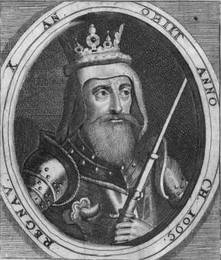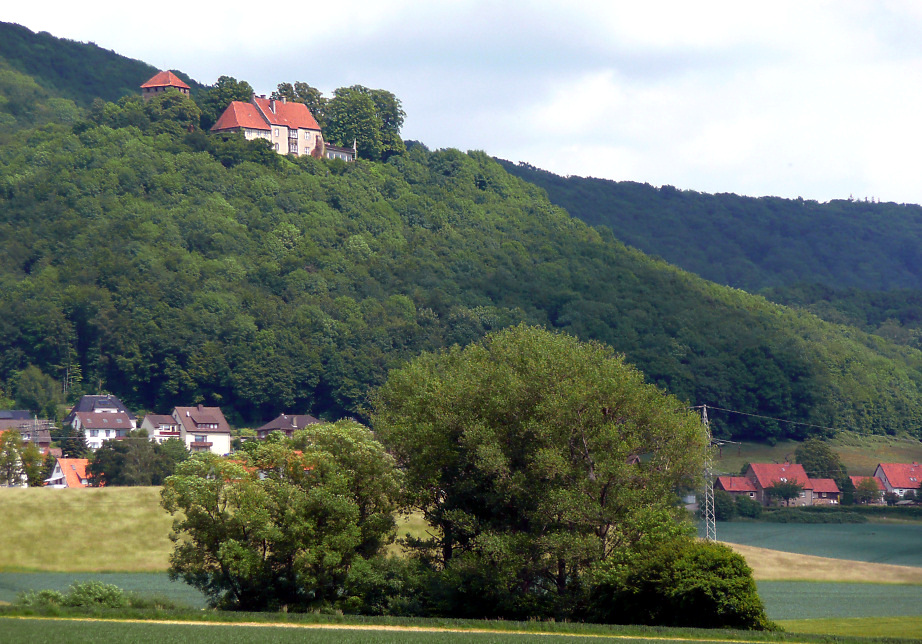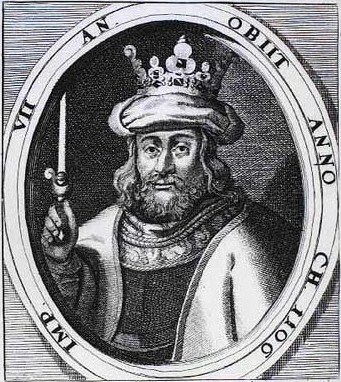|
Gerhard VI, Count Of Holstein-Rendsburg
Gerhard VI (c. 1367–1404) was the Count of Holstein-Rendsburg from 1382, and Duke of Schleswig as of 1386. Gerhard VI was born around 1367, the son of Count Henry II from the Rendsburg line of the House of Schauenburg and Ingeborg of Mecklenburg. After the death, in 1381 or 1384, of his father, who had ruled jointly with Gerhard's uncle Nicholas (Claus), Gerhard and his younger brother Albert II entered into the joint government for their late father. On 15 September 1386 King Olav III of Denmark enfeoffed him with the Duchy of Schleswig, after his uncle Nicholas had resigned from that function. In 1390 Gerhard and his brother and uncle inherited Holstein-Kiel, including the merged Plön, whose line had been extinct in 1350. After their uncle Nicholas had died in 1397 the brothers divided their possessions, the elder keeping Schleswig and Holstein-Rendsburg, and Albert II receiving Holstein-Segeberg as secundogeniture. In 1403 Gerhard regained Segeberg by way of reversion u ... [...More Info...] [...Related Items...] OR: [Wikipedia] [Google] [Baidu] |
House Of Schauenburg
The House of Schaumburg was a dynasty of German rulers. Until c. 1485, it was also known as the House of Schauenburg. Together with its ancestral possession, the County of Schaumburg, the family also ruled the County of Holstein and its partitions Holstein-Itzehoe, Holstein-Kiel, Holstein-Pinneberg (till 1640), Holstein-Plön, Holstein-Segeberg and Holstein-Rendsburg (till 1460) and through the latter at times also the Duchy of Schleswig. History The Schaumburgs were named after Schaumburg Castle, Lower Saxony, Schauenburg Castle, near Rinteln on the Weser, where the owners started calling themselves Lords (from 1295 Counts) of Schauenburg. Adolf I, Count of Holstein, Adolf I probably became the first Lord of Schauenburg in 1106. In 1110, Adolf I, Count of Holstein, Adolf I, Lord of Schauenburg was appointed by Lothair, Duke of Saxony to hold Holstein and Stormarn (gau), Stormarn, including Hamburg, as fiefs.Lemma Schauenburg/Schaumburg. In: Klaus-Joachim Lorenzen-Schmidt, Ortwin ... [...More Info...] [...Related Items...] OR: [Wikipedia] [Google] [Baidu] |
Ditmarsh
Dithmarschen (, Low Saxon: ; archaic English: ''Ditmarsh''; da, Ditmarsken; la, label=Medieval Latin, Tedmarsgo) is a district in Schleswig-Holstein, Germany. It is bounded by (from the north and clockwise) the districts of Nordfriesland, Schleswig-Flensburg, Rendsburg-Eckernförde, and Steinburg, by the state of Lower Saxony (district of Stade, from which it is separated by the Elbe river), and by the North Sea. From the 13th century up to 1559 Dithmarschen was an independent peasant republic within the Holy Roman Empire and a member of the Hanseatic League. Geography The district is located on the North Sea. It is embraced by the Elbe estuary to the south and the Eider estuary to the north. Today it forms a kind of artificial island, surrounded by the Eider river in the north and the Kiel Canal in both the east and southeast. It is a rather flat countryside that was once full of fens and swamps. To the north it borders on Nordfriesland and Schleswig-Flensburg, to the east o ... [...More Info...] [...Related Items...] OR: [Wikipedia] [Google] [Baidu] |
Adolph IX, Count Of Holstein-Kiel
Adolph IX, Count of Holstein-Kiel, also known as ''Adolph VII'',The numbering varies between authors: some authors call him Adolph VII, because there were six earlier Adolphs among his male-line ancestors in the House of Schauenburg, others call him Adolph IX, because there were two more earlier Adolphs in other lines. ( – 26 January 1390) was count of Holstein-Kiel and Holstein-Plön from 1359 until his death. Life His parents were John III "the Mild" ( – 27 September 1359) and Catherine (died 1327), the daughter of Duke Henry III of Glogów and the widow of Margrave John V of Brandenburg (1302–1317). In December 1362, Adolph IX married Anna of Mecklenburg-Schwerin (1343–1415), the daughter of Albert II, Duke of Mecklenburg. Adolph's reign was mostly peaceful. In 1375, Prince-Archbishop Albert II of Bremen mortgaged the Haseldorf Marsh to him. The prince-archbishop of Bremen later failed to redeem the mortgage, and the Haseldorf Marsh has been part of Holstei ... [...More Info...] [...Related Items...] OR: [Wikipedia] [Google] [Baidu] |
List Of The Dukes Of Schleswig
The following is a list of jarls and dukes, who ruled over Schleswig respectively Southern Jutland (Sønderjylland). First jarls/dukes Houses of Estridsen and Schauenburg (1080–1460) House of Oldenburg In 1864, following the Second Schleswig War, the Duchy of Schleswig-Holstein became an occupied territory of the German Confederation and two years later, following the Austro-Prussian War, part of the new Prussian Province of Schleswig-Holstein. See also *List of Danish monarchs *List of rulers of Schleswig-Holstein The following is a list of rulers (usually dukes) who ruled both Schleswig and Holstein, starting from the first Holstein count who received Schleswig, until both territories were annexed by the Kingdom of Prussia in 1866; and afterwards, titular ... Notes {{DEFAULTSORT:Schleswig, Dukes Of Lists of Danish people Lists of monarchs Dukedoms of Germany People from the Duchy of Schleswig * Lists of dukes ... [...More Info...] [...Related Items...] OR: [Wikipedia] [Google] [Baidu] |
House Of Schaumburg
The House of Schaumburg was a dynasty of German rulers. Until c. 1485, it was also known as the House of Schauenburg. Together with its ancestral possession, the County of Schaumburg, the family also ruled the County of Holstein and its partitions Holstein-Itzehoe, Holstein-Kiel, Holstein-Pinneberg (till 1640), Holstein-Plön, Holstein-Segeberg and Holstein-Rendsburg (till 1460) and through the latter at times also the Duchy of Schleswig. History The Schaumburgs were named after Schauenburg Castle, near Rinteln on the Weser, where the owners started calling themselves Lords (from 1295 Counts) of Schauenburg. Adolf I probably became the first Lord of Schauenburg in 1106. In 1110, Adolf I, Lord of Schauenburg was appointed by Lothair, Duke of Saxony to hold Holstein and Stormarn, including Hamburg, as fiefs.Lemma Schauenburg/Schaumburg. In: Klaus-Joachim Lorenzen-Schmidt, Ortwin Pelc (Hrsg.): ''Schleswig-Holstein Lexikon''. 2. Aufl., Wachholtz, Neumünster, 2006. Holstein was ... [...More Info...] [...Related Items...] OR: [Wikipedia] [Google] [Baidu] |
List Of Rulers Of Schleswig-Holstein
The following is a list of rulers (usually dukes) who ruled both Schleswig and Holstein, starting from the first Holstein count who received Schleswig, until both territories were annexed by the Kingdom of Prussia in 1866; and afterwards, titular dukes. The Houses of Schauenburg and Estridsen In the course of history, the County of Holstein was several times partitioned among the inheriting sons into up to six lines. In 1386 King Oluf II of Denmark and his mother-regent, Queen Margaret I, enfeoffed in Nyborg Gerhard VI, Count of Holstein-Rendsborg and his cognatic successors with the Duchy of Schleswig, which had been in the royal family's hands until 1375. He was as Gerhard II duke of Schleswig. Until 1390 the Rendsborg branch united by inheritance all branches except of that of Holstein-Pinneberg. It remaining a separately ruled territory in Holstein until its line was extinct in 1640, when Holstein-Pinneberg was merged into the then Duchy of Holstein. Furthermore, the here ... [...More Info...] [...Related Items...] OR: [Wikipedia] [Google] [Baidu] |
Gerhard VII, Count Of Holstein
Gerhard VII, Count of Holstein-Rendsburg (1404 – 24 July 1433 in Emmerich am Rhein) was Count of Holstein-Rendsburg and by claim also Duke of Schleswig, as Gerhard III. He was the youngest son of Gerhard VI and his wife Elizabeth of Brunswick. Life During the Danish-Hanseatic War, together with his elder brothers Henry IV and Adolf VIII, he fought on the side of the Hanseatic League against Denmark. In 1428, he took part as commander of the city fleet in the attack of Flensburg and the bombardment of Copenhagen by the Hanseatic League. In 1427, Gerhard VII and his brother Adolf VIII jointly took over the Duchy of Schleswig from their other fallen brother Henry IV (as Henry III duke of Schleswig). On 2 June 1432, Gerhard VII married Agnes, the daughter of Margrave Bernard I of Baden. On 15 January 1433, she fell from the stairs and went into labour. She gave birth to healthy twins: Henry and Catherine. It was fairly clear that she must have been pregnant on the ... [...More Info...] [...Related Items...] OR: [Wikipedia] [Google] [Baidu] |
Adolf VIII, Count Of Holstein
Adolphus XI of Schauenburg ( nds, Alef or Alv, german: Adolf von Schauenburg, da, Adolf 8. af Holsten-Rendsborg) (1401 – 4 December 1459), as Adolph I Duke of Schleswig ( da, Sønderjylland, formerly ), and as Adolph VIII Count of Holstein-Rendsburg, was the mightiest vassal of the Danish realm. Background Adolph descended from a branch of the House of Schauenburg, who had for centuries been counts of Holstein, and as such, vassals of the Holy Roman Empire. His great-grandfather Gerhard the Great, having also been a Regent of the Kingdom of Denmark, had received the Duchy of Sønderjylland from the Danish crown as a hereditary fief. It had been lost for the Schauenburgs between 1330 and 1375, with Queen Margaret I of Denmark restricting the regained ducal power in 1386, and again from 1414 to 1440. Count Adolph's parents were Gerhard VI, Count of Holstein-Rendsburg and Catherine Elisabeth of Brunswick-Lüneburg. Adolph was only three years old when his father was killed ... [...More Info...] [...Related Items...] OR: [Wikipedia] [Google] [Baidu] |
Christian I Of Denmark
Christian I (February 1426 – 21 May 1481) was a Scandinavian monarch under the Kalmar Union. He was king of Denmark (1448–1481), Norway (1450–1481) and Sweden (1457–1464). From 1460 to 1481, he was also duke of Schleswig (within Denmark) and count (after 1474, duke) of Holstein (within the Holy Roman Empire). He was the first king of the House of Oldenburg. In the power vacuum that arose following the death of King Christopher of Bavaria (1416–1448) without a direct heir, Sweden elected Charles VIII of Sweden (14081470) king with the intent to reestablish the union under a Swedish king. Charles was elected king of Norway in the following year. However the counts of Holstein made the Danish Privy Council appoint Christian as king of Denmark. His subsequent accessions to the thrones of Norway (in 1450) and Sweden (in 1457), restored the unity of the Kalmar Union for a short period. In 1463, Sweden broke away from the union and Christian's attempt at a reconquest res ... [...More Info...] [...Related Items...] OR: [Wikipedia] [Google] [Baidu] |
Dietrich Of Oldenburg
Dietrich () is an ancient German name meaning "Ruler of the People.” Also "keeper of the keys" or a "lockpick" either the tool or the profession. Given name * Dietrich, Count of Oldenburg (c. 1398 – 1440) * Thierry of Alsace (german: Dietrich, link=no; 1099–1168), Count of Flanders * Dietrich of Ringelheim (9th century), Saxon count and father of St Matilda * Dietrich Bonhoeffer (1906–1945), German Lutheran pastor and theologian * Wilhelm Dietrich von Buddenbrock (1672–1757), Prussian field marshal and cavalry leader * Dieterich Buxtehude (c. 1637/39–1707), Danish-German composer and organist * Dietrich von Choltitz (1894–1966), German General and last commander of Nazi-occupied Paris in 1944 * Dietrich Eckart (1868–1923), German politician * Dietrich Enns (born 1991), American baseball player * Dietrich Fischer-Dieskau (1925–2012), German baritone singer * Dietrich von Hildebrand (1889–1977), German Catholic philosopher and theologian * Dietrich Hollinderbä ... [...More Info...] [...Related Items...] OR: [Wikipedia] [Google] [Baidu] |
Helvig Of Schauenburg
Helvig of Schauenburg (german: Heilwig von Holstein) (1398–1436) was a duchess of Schleswig and a countess of Holstein from the family of Schauenburg. She was the mother of King Christian I of Denmark and ancestor of the Danish Royal houses of Oldenburg and Schleswig-Holstein-Sonderburg-Glücksburg. Biography She was a daughter of Gerhard VI of Holstein-Rendsburg and his wife, Catherine Elisabeth of Brunswick-Lüneburg. Her brother was Adolf VIII/I, Count of Holstein/Duke of Schleswig. Through their father, they were cognatic descendants of King Eric V of Denmark (1249–1286) while through their mother, they were cognatic descendants of King Abel of Denmark (1218–1252). On 18 April 1417 Helvig was married to Prince Balthasar of Mecklenburg, who died of the plague in 1421. In 1423 she was married to Dietrich, Count of Oldenburg. From her second marriage she had the following children: * Christian I of Denmark (1426–1481), who succeeded his father as Count of Oldenburg a ... [...More Info...] [...Related Items...] OR: [Wikipedia] [Google] [Baidu] |
Ingeborg Of Holstein
Ingeborg of Holstein (1396 – 14 October 1465), was Abbess of Vadstena Abbey 1447-1452 and 1457-1465. She was the daughter of Gerhard VI, Count of Holstein-Rendsburg (d. 1404) and Catherine Elisabeth of Brunswick-Lüneburg. In 1408, she was placed in the convent by Queen Margaret I of Denmark by special consent of the Pope. She became a full member of the order in 1415. Due to her age, it is believed that she initially resided in her own house on the convent premises. In 1447, she was appointed Abbess. Her election was controversial and an active opposition remained against her appointment. She had the loyal support of the confessor of the abbey, Magnus Unnonis. Ingeborg was the maternal aunt of King Christian I of Denmark, which was likely the cause to why King Charles VIII of Sweden 25 April 1452 demanded that she and the confessor of the abbey, Magnus Unnonis, should be deposed. Bishop Nils König of Linköping saw no cause for this, but both Ingeborg and Unnonis stepped down ... [...More Info...] [...Related Items...] OR: [Wikipedia] [Google] [Baidu] |
_01.jpg)



_01.jpg)
